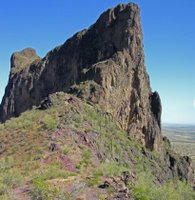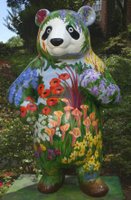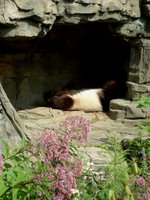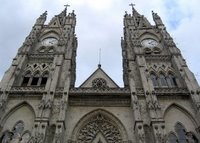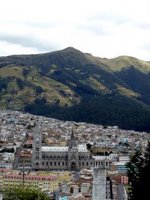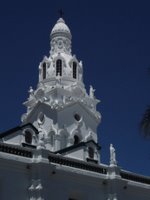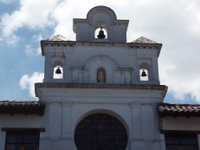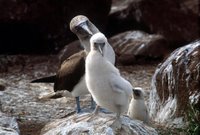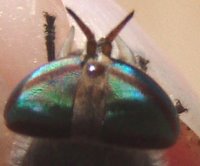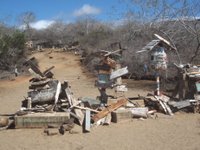I woke up early and caught a taxi to the airport. Once there, I met the representative from the yacht, who checked all of the passengers in. It looks like there will be 13 of us on the Beluga.
There was a group of 5 Americans from the Delaware Nature Society, a German couple, a father and daughter from Quito, a Scottish couple, a Brazilian man, and me. I wasn't quite sure how the other 5 Americans were partnered (2 men, 3 women) until we got aboard the yacht and I learned that I had a cabin all to myself.
North Seymour IslandAfter formal introductions and lunch on the Beluga, we had a chance to unpack as we were "sailing" to the first island, North Seymour. Once we arrived at North Seymour, we had a fire drill, and then we were ready to get in the pangas (inflatable dinghies) to head to the island.

This was a dry landing - meaning the dinghy stopped at the edge of a cliff, with steps formed in it. We then had to get out of the dinghy, bouncing in the waves, and scramble up the side of the cliff. It actually wasn´t as hard as it looked (or sounded).
Once on land, it was a fairly easy trail, although there was quite a bit of congestion at first. Instead of climbing to the top of the hill where the trail started, people were stopping to snap pictures of swallow-tailed gulls nesting. A couple of them were sitting on eggs. There were also quite a few Sally Lightfoot Crabs around, that people were taking pictures of. Our guide yelled at everyone to move to the top of the hill. Hopefully he won´t yell at us the entire trip!

At first the trail was fairly flat and sandy, winding past a shoreline full of sea lions and a few small, black marine iguanas. We were also able to find the rarer, lava gull. Further inland, we could see nesting colonies of great and magnificant frigate birds. People started zooming in on them, but the guide told us we would get much closer in a little while.

Along the path, there were a couple of land iguanas - most of them hiding under bushes. While the guide was explaining something, I wandered a little bit off, and tried to get pictures of the land iguana eating. Twigs from the bushes got in the way of the pictures though.
As we got closer to the frigate birds, the trail got more rocky, to the point that we were scrambling over all rocks. I had to go rather slow, since I'm not quite all that coordinated, and I didn't want to sprain my ankle on the first day!
The frigate birds were amazing!

The males puffed up the red pouch under their neck to attract females. They tipped their heads way back and made a clacking noise. Females would swoop down to check out the males. Some of them stayed only seconds before flying away. Lincoln (the Brazilian guy) and I cracked jokes about it being harder than a singles bar for the males.
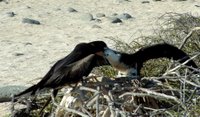
Along with the adult frigate birds, there were also several juveniles in the nests. The great frigate
bird juveniles had rust colored heads, and the magnificant juveniles had white colored heads. In one nest, the juvenile was screaming out to be fed. When the mother came back to feed it, the nest was swarmed with other adults, trying to steal the food.
We also saw a juvenile blue footed boobie, but not adults.

After the walk, we got back in the panga to go to the yacht. Hopefully I will get more adept at getting into and out of the panga as the week goes on.
Once back on board, we had an appetizer and welcome cocktail, then dinner. After dinner, we received the evening briefing for the next day. We were also told that we had a long sail that night, and the seas might be rough. We were advised to take a motion sickness pill right away if we needed one, since we would be moving in an hour.
Having never been motion sick before, I passed on taking the pill. I was fine when the ship was moving - until I got in bed. Then I felt queasy. I probably could have fought the urge to be ill all night, but decided that the combination of too much dinner and the motion was more than I could stomach. Once I threw up, I felt much better, and had no problem sleeping the rest of the night.
 A couple of weeks ago, I had to go to Tucson for work. On the way back to Phoenix, the sun was setting as I approached Picacho Peak. I decided to stop to see if I could get some good pictures. Unfortunately, by the time I got to the exit, the sun was a little too low in the sky to get a good shot from Picacho Peak.
A couple of weeks ago, I had to go to Tucson for work. On the way back to Phoenix, the sun was setting as I approached Picacho Peak. I decided to stop to see if I could get some good pictures. Unfortunately, by the time I got to the exit, the sun was a little too low in the sky to get a good shot from Picacho Peak. I had hoped to get a few shots of the mountain with pink and red sky behind it, but instead, the sky turned gray and then it got dark. Below are a couple of the pictures I took.
I had hoped to get a few shots of the mountain with pink and red sky behind it, but instead, the sky turned gray and then it got dark. Below are a couple of the pictures I took.